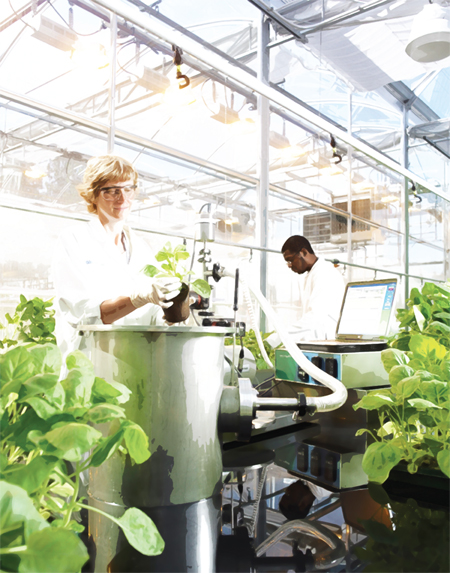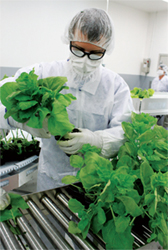Medicago's Innovative Vaccine Production Using Tobacco Plants
By Wayne Koberstein, executive editor
In the American South, below the old Mason-Dixon Line, you can walk down some house-lined streets in summer and see tidy plantings of tobacco growing in the front yards. Tobacco barns, built for drying, not storing, are as common down there as hay barns in Wisconsin.

The tobacco culture runs deep, which may help explain why a company from Canada found its way to North Carolina to build a new facility using tobacco plants as the means of vaccine production. The new “plant” in Durham, near Research Triangle Park, greatly expands capacity from Medicago’s original model facility near its headquarters in Québec City, Québec, Canada.
You can certainly read about Medicago’s technology and product pipeline on its website, but you may come away with an appetite for more than the terse and fairly general explanations therein. Even the technical descriptions leave much to the imagination, and you will not get much of a sense of how the company came to be. Though still a virtual unknown after nearly 17 years in business, Medicago is a late-stage clinical developer that has built itself an infrastructure of seemingly commercial dimensions.
The Durham plant, at 97,000 square feet, quadruples the original production space in Québec. It includes a huge, automated greenhouse and equipment to extract product from the tobacco leaves, purify it, and package finished doses — up to 30 million vaccines for seasonal flu or 120,000 for pandemic flu.
The company’s proprietary manufacturing platform, Proficia, is nothing if not revolutionary, perhaps even worthy of the highly prized appellation “disruptive” — if all your bets are riding on traditional technology for making vaccines and antibodies. The Proficia process inserts genetic material into live tobacco leaves to induce a temporary or “transient” expression of what the company calls “virus-like particles” (VLPs) that mimic viruses but cannot reproduce or cause disease on their own.
Although VLPs lack the genetic core of the disease-causing virus, they display the same antigens on a similar structure and thus mobilize the immune system against it. Medicago employs its related “high-throughput” platform, VLPExpress, to rapidly identify the key antigens and design the VLP “presentations.” With further refinement, Proficia will also produce antibodies.
GROWTH WITH DIRECTION
Medicago’s current president and CEO, Andy Sheldon, joined the company in mid-2003 with an extensive background in vaccines at Rhône Mérieux, then part of Rhône-Poulenc Rorer, and later at Shire Biologics. Sheldon was attracted both to the opportunity for a new manufacturing technology and to the potential for developing new products on the platform, he says. But the company was still largely research-based — founder Louis-Philippe Vézina, now the CSO — was also its platform inventor. And, like the typical early start-up developing new technology, the company was unsure of its commercial direction. (See “The Micro-Innovators,” Life Science Leader, December 2013 and January 2014.)
“The whole plant-based manufacturing concept was focused principally on making large quantities of product. Many of the initial companies in the plant world wanted to be contract manufacturers. But it was always difficult to see how we could possibly be a contract manufacturer if we had never actually taken our own products to market,” Sheldon says.
In 2005, Sheldon introduced his board to the idea of the company starting work on a pandemic influenza vaccine and permanently adopting the product-development model. Since then, he says, “We have demonstrated we do have a major role to play in the protection of citizens in any country against a pandemic.” The next step for Medicago is to demonstrate how its new-product development, based on the same platform, can expand into other areas beyond vaccines, such as those now reserved for antibodies and peptides. Meanwhile, the company continues to improve the quality, capacity, and efficiency of its tobacco-plant vaccine technology, according to Sheldon.
He suggests that, although scientific freedom creates opportunities, business depends on inspiring company scientists toward some common goals — in this case, products and platform quality. “The real value of the company lies in what differentiates it from everyone else — how we strategically position the product, and also our platform’s ability to produce consistently, cost-effectively, and efficiently.” Quality, an oft-heard industrial term, can sound as unfamiliar to company researchers as does “product focus,” and Medicago’s manufacturing base offers them another “learning experience,” he says.
“Getting our scientists to start thinking about documentation and traceability, and all the other aspects of production, has really paid off in spades for us. Today, our people in research are the first ones to think about those things, which is very rewarding.”
The emphasis on manufacturing also has aided Medicago in its clinical development programs — led by an H5 pandemic flu vaccine preparing for Phase 3 and a quadrivalent seasonal flu vax entering Phase 2. Unlike many other life sciences start-ups, the company has scaled up its capacity and facilities internally to match demand for its Phase 3 trials, and with obvious order.
“From creating VLP technology to working on extremely complex products such as rotavirus, quadrivalent flu, and pandemic flu vaccines, we have come to see what else this technology can do, not only in the world of vaccines, but eventually in other areas such as biobetters and biosimilars,” Sheldon says. He believes the company has proved its concept, giving it good reason for confidence in its technology. The VLP approach is further validated, he says, by Medicago’s DARPA (U.S. Defense Advanced Research Projects Agency) and Canadian government financial support through a number of grants — and its recent acquisition by Mitsubishi Tanabe.
FUNDING BY PURCHASE
Yes, I said acquisition. Mitsubishi Tanabe Pharma (MTP) purchased 60 percent of Medicago in September 2013, delisting Medicago’s stock and leaving the remaining 40 percent of shares in the hands of Philip Morris Investments.
So, why am I still writing about Medicago and not Mitsubishi at this point? Well, for the time being and as long into the future as anyone can see, the Japanese company seems to value the acquired company’s distinct identity, management, and operations. Sheldon is optimistic about the business- and product-development prospects for their combined businesses, but he is also sanguine about the underlying rationale for the merger: the cost of latestage clinical trials.
“As we moved forward with our Phase 2 and Phase 3 trials in flu, it became necessary for the company to look at all the options — either licensing or selling the company, or trying to continue on with private or public financing. Right now we have CROs to ensure that the trials are done appropriately and in a timely fashion, and with the merger, we have the financial resources to do that. All companies face the same choices at some time, and I believe we have found the right solution with a perfect marriage of shareholders, which allows us to continue on and drive these products to the market.”
For Mitsubishi, the acquisition is a big step forward into biologics, a goal for company expansion. Sheldon says MTP was “looking for a leap-ahead technology that could allow them to be a world player in biologics.” The two companies have been partners since March 2012, working together on a rotavirus project and other collaborations. “Now Mitsubishi has the technology platform and development products to start building a brand new vaccine entity, and our goal is make Medicago part of what will become a major leader in vaccines worldwide.”
Andy Sheldon, President and CEO

“You’ll hate this word, but I’m going to say it anyway, because I like it — we believe we have a disruptive technology,” says Sheldon. He argues Proficia’s plantbased process is, “by definition,” a great improvement in production speed, efficiency, cost-effectiveness, and outright cost-of-goods. Even though worldwide vaccine production would require building even more capacity, he figures the company has time to grow because market penetration would be gradual.
“But if truly our first product proves to be a better vaccine in the elderly, which we believe it will be, we will be in the position where people see we can actually manufacture better product. Then I think we’re on a winning ascent, and our technology will be disruptive — and yes, it could change the way people think.”
Medicago’s story recalls how biotech first got started: mainly as a manufacturing alternative, only then with E. coli or yeast cells. “We’ve got this plant in front of us, a living system, and it can make very complex molecules. And it’s quite likely we’ll find out over time that we’re able to do things existing technologies cannot do.”
It would not be surprising if Medicago meets with some pushback from traditional as well as other innovative vaccine makers as the company gains more visibility. Some companies are developing vaccines based on DNA technologies or other platforms that might or might not be compatible with VLPs, and longestablished doctrine favors live, animalbased vaccines for invoking a strong immune response.
But so far in the clinical trials for its pandemic flu candidates, Medicago’s approach appears to produce potent immune stimulation and immunological memory, according to the company. “We are doing a lot of extra work to demonstrate what we’ve always believed — we can make better vaccines with this technology than existing technology, with a strong parallel between us and live viruses.”
Regulators might be expected to take a longer look at such a different means of manufacturing. Sheldon expresses no qualms, however. “When we work through clinical trials, the rules are the same. We must be able to demonstrate safety and efficacy and purity of product, exactly as with cell-culture, egg-based, or any other vaccine types.”
Sheldon says the main distinction between Medicago vaccines and all others is in the upstream production phase — it uses biomass generation of plant tissue — but he says downstream purification technologies are standard. Still, anticipating some additional regulatory hurdles with a new technology, the company compensated by attending to its quality and documentation systems from the beginning. “We were even ahead of where we needed to be as a biotech company, and over time we’ll work as closely as possible with the regulatory agencies.”
PLANTS OVER THE HORIZON
Even at best, the company faces a long road to its ultimate goal: expanding its technology beyond vaccines to generate scaffolds for therapeutic antibodies, most likely to improve on existing mAbs (monoclonal antibodies). The expansion is not commercially driven, according to Sheldon; instead, the company’s deepening investigation into its own technology revealed a broader potential.
 “When we first started to produce these virus-like particles, we had no way of knowing the plants would produce these complex antigen structures, where you have an antigen sticking out from the lipid layer, looking just like a virus. People have been making VLPs, for example, in insect cells, where you need to add various proteins to hold the particle together. Lo and behold, the plant expresses the same proteins in its plasma membrane. Now we know we may be able to use these particles as chimerics — the stem sticking out from the lipid layer could be something other than a viral antigen. We’ll see where the science takes us, but we may find some rather interesting solutions to very complex problems.”
“When we first started to produce these virus-like particles, we had no way of knowing the plants would produce these complex antigen structures, where you have an antigen sticking out from the lipid layer, looking just like a virus. People have been making VLPs, for example, in insect cells, where you need to add various proteins to hold the particle together. Lo and behold, the plant expresses the same proteins in its plasma membrane. Now we know we may be able to use these particles as chimerics — the stem sticking out from the lipid layer could be something other than a viral antigen. We’ll see where the science takes us, but we may find some rather interesting solutions to very complex problems.”
Among the possible areas of application for Medicago’s platform are cancer immunotherapy and HIV vaccination. “Although we have actually produced a virus-like particle for HIV, we’ve never taken it anywhere,” says Sheldon. “It is blue sky, but nonetheless, it’s a real blue sky.”
Because Medicago is building a new, plant-based technology, it finds itself in a leadership position, compared to companies in the same space that lack a product focus. (One company, Protalix Biotherapeutics — using plant cells rather than growing plants to produce proteins — has a hormone-replacement product on the market.) If Medicago succeeds in validating its leading role among the plant-growers in vaccine and protein production, Sheldon would credit its “adaptability” for putting it ahead of the pack. Fair to say, when you’re pioneering a way to make medicines from tobacco, adaptation is your game —by definition.
Proficia Pluses
Medicago’s 97,000 square-foot vaccine-production plant in Durham, NC — using tobacco to produce vaccines made of “virus-like particles” grown in tobacco — cost only $40 million to build, versus the hundreds of millions to more than $1 billion required for a typical cell-based plant. That means Proficia, the company’s name for its VLP (virus-like particles) platform, is “less expensive than others and certainly more cost-effective — even for things like a quadrivalent influenza vaccine, which is a complex project,” according to president and CEO Andy Sheldon.
Speed of production is very important with certain vaccines, such as one for pandemic flu. In 2009, in a test of its H1 flu candidate, the company “managed to put a protein in a vial with high purity within about 19 days,” Sheldon says, “and we did it again with H7 earlier this year, and the H7 project has continued on.
“That year, H1 flu surfaced in Canada in April 2009, but the Canadian vaccine for H1 was not available until mid-October in any meaningful numbers, and we know that we could have certainly beaten that time line by several months.”
The method Medicago uses to configure any vaccine, called VLPExpress, resembles an IT technology, based on Sheldon’s description: “We just need the genetic sequence. We can just download the sequence from the Internet and away we go. We go to the lab, we make the DNA fragment, and we put it in a column where we start the phases of manufacturing. The process allows us to program our tobacco leaves. Meanwhile, others have to wait for the viral strain to arrive from the CDC and other authorities.”
The Proficia Process
- Synthesis
Gene synthesized from sequence of pandemic virus. - Vacuum Infiltration
Genetic material introduced into plants through vacuum. - Incubation
Plants are incubated four to seven days in growth chambers for protein expression and VLP formation. - Harvest
Plants are harvested to extract VLPs. - Purification
VLPs are purified to obtain clinical-grade material. - Finished Vaccine
- Potent immune stimulation
- Immunological memory
- Lower dosage
- No genetic material (noninfectious)
The Novelties Of VLPs
Medicago’s CEO Andy Sheldon expounds on the characteristics and potential advantages of the “viral-like particles” (VLPs) produced by the company’s tobacco-based vaccine technology:
“VLPs confer all the great benefits of a live virus in a vaccine, but they are not live, they do not have any genetic material, and therefore they have better safety aspects. The virus-like particle for influenza is very similar in size to the naturally occurring influenza particles. We have seen now, through our clinical trials on H1 and H5 flu vaccines, that we have the opportunity for some cross reactivity, and thus cross protection. In other words, the VLP structure may confer a better immunity than existing technologies by protecting against more strains, as well as elucidating both of the pathways needed to induce cell-mediated immunity. And we’re working hard to demonstrate that. A simple example would be in the elderly, who often lack the antibodies but resist influenza because they have cell-mediated immunity, or T-cell responses. So we believe we may have some huge advantages in the marketplace with a more efficacious product, all due to the structure of the virus-like particle.”
